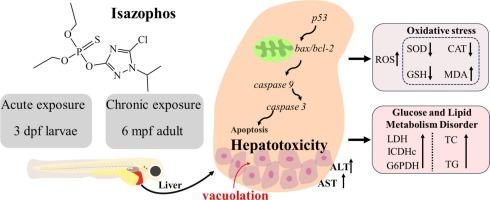Hepatic toxicity assessment of organophosphorus insecticide isazophos on zebrafish
IF 4.3
3区 环境科学与生态学
Q2 BIOCHEMISTRY & MOLECULAR BIOLOGY
Comparative Biochemistry and Physiology C-toxicology & Pharmacology
Pub Date : 2025-08-11
DOI:10.1016/j.cbpc.2025.110324
引用次数: 0
Abstract
Isazophos, an organophosphorus insecticide, is a prevalent environmental contaminant that bioaccumulates in organisms and poses significant risks to human health. However, the organ toxicity of isazophos to aquatic organisms has not been previously characterized. The purpose of this study is to investigate the toxic effects of isazophos exposure on zabrafish liver, as well as revealing the underlying toxicological mechanisms. Acute and chronic toxicity assessments showed 72 h and 28 days lethal concentration (LC50) values of 2.612 mg/L and 0.172 mg/L for zebrafish embryos and adult zebrafish, respectively. The level of superoxide dismutase (SOD), catalase (CAT), glutathione (GSH) and inflammation related genes revealed that isazophos affects early zebrafish development and causes liver damage via reactive oxygen species (ROS)-induced oxidative stress and inflammatory with upregulated pro-inflammatory factors (il-6, il-8, il-1β and TNF-α). Moreover, when exposed to isazophos, the glycogen content of the liver was decreased, while lipid accumulation was increased, and liver metabolism-related indices were changed. The ratios of pro-apoptotic genes p53, bax/bcl-2, caspase 9 and caspase 3 were upregulated. And the caspase3 and cleaved-caspase3 protein expression was evaluated in the isazophos group, revealing that isazophos caused aptoptotic. In conclusion, isazophos induces oxidative stress through the production of ROS, leading to the activation of pathways associated with apoptosis. The present study provides a systematic analysis of isazophos-induced hepatic effects in zebrafish liver and demonstrates that exposure to isazophos affects normal hepatic metabolism.

有机磷杀虫剂异唑磷对斑马鱼的肝毒性评价。
异唑磷是一种有机磷杀虫剂,是一种普遍存在的环境污染物,可在生物体中生物积累,对人类健康构成重大风险。然而,异唑磷对水生生物的器官毒性以前没有被描述过。本研究旨在探讨异唑磷对斑马鱼肝脏的毒性作用,并揭示其潜在的毒理学机制。急性和慢性毒性评估显示,斑马鱼胚胎72 h和成年斑马鱼28 d的致死浓度(LC50)分别为2.612 mg/L和0.172 mg/L。超氧化物歧化酶(SOD)、过氧化氢酶(CAT)、谷胱甘肽(GSH)和炎症相关基因的水平表明,异唑磷影响斑马鱼的早期发育,通过活性氧(ROS)诱导的氧化应激和炎症,通过上调促炎因子(il-6、il-8、il-1β和TNF-α)导致肝脏损伤。此外,暴露于异唑磷后,肝脏糖原含量降低,脂质积累增加,肝脏代谢相关指标发生变化。促凋亡基因p53、bax/bcl-2、caspase 9、caspase 3比值上调。检测异唑磷组caspase3和cleaved-caspase3蛋白表达,发现异唑磷引起细胞凋亡。综上所述,异唑磷通过产生ROS诱导氧化应激,从而激活与细胞凋亡相关的通路。本研究系统分析了异唑磷对斑马鱼肝脏的影响,并证明暴露于异唑磷会影响正常的肝脏代谢。
本文章由计算机程序翻译,如有差异,请以英文原文为准。
求助全文
约1分钟内获得全文
求助全文
来源期刊
CiteScore
7.50
自引率
5.10%
发文量
206
审稿时长
30 days
期刊介绍:
Part C: Toxicology and Pharmacology. This journal is concerned with chemical and drug action at different levels of organization, biotransformation of xenobiotics, mechanisms of toxicity, including reactive oxygen species and carcinogenesis, endocrine disruptors, natural products chemistry, and signal transduction with a molecular approach to these fields.

 求助内容:
求助内容: 应助结果提醒方式:
应助结果提醒方式:


